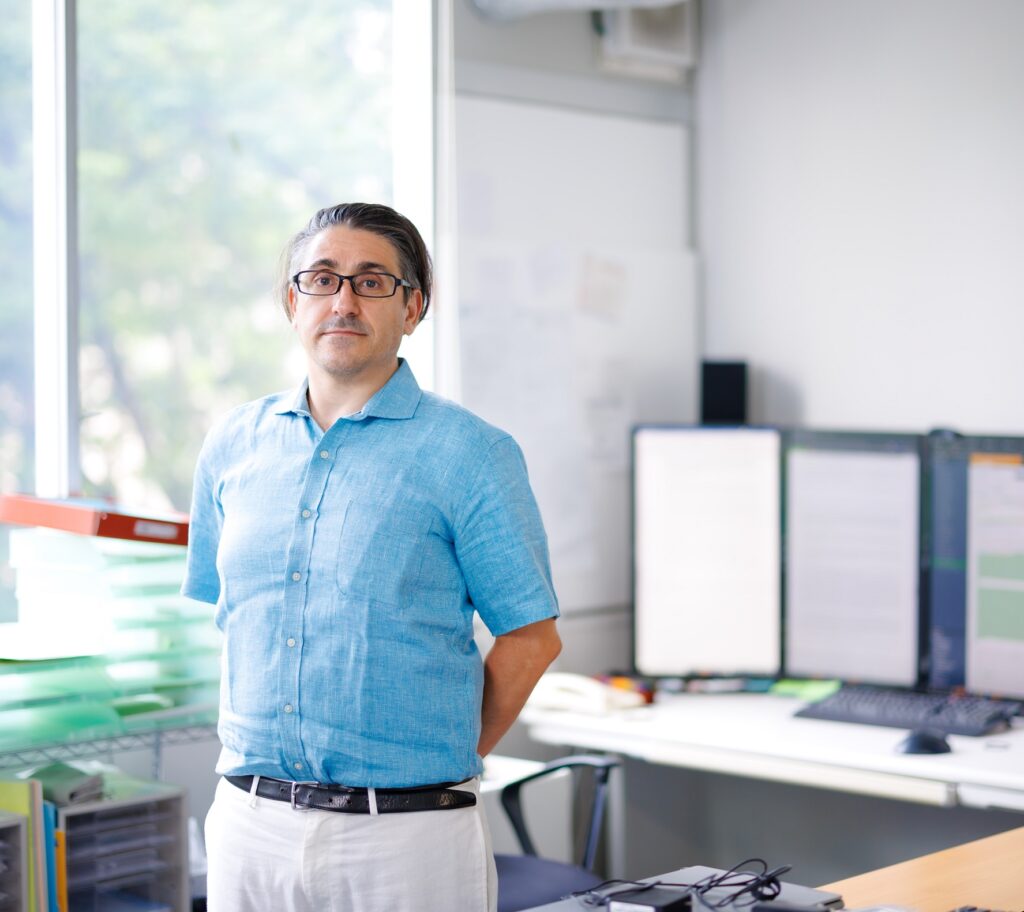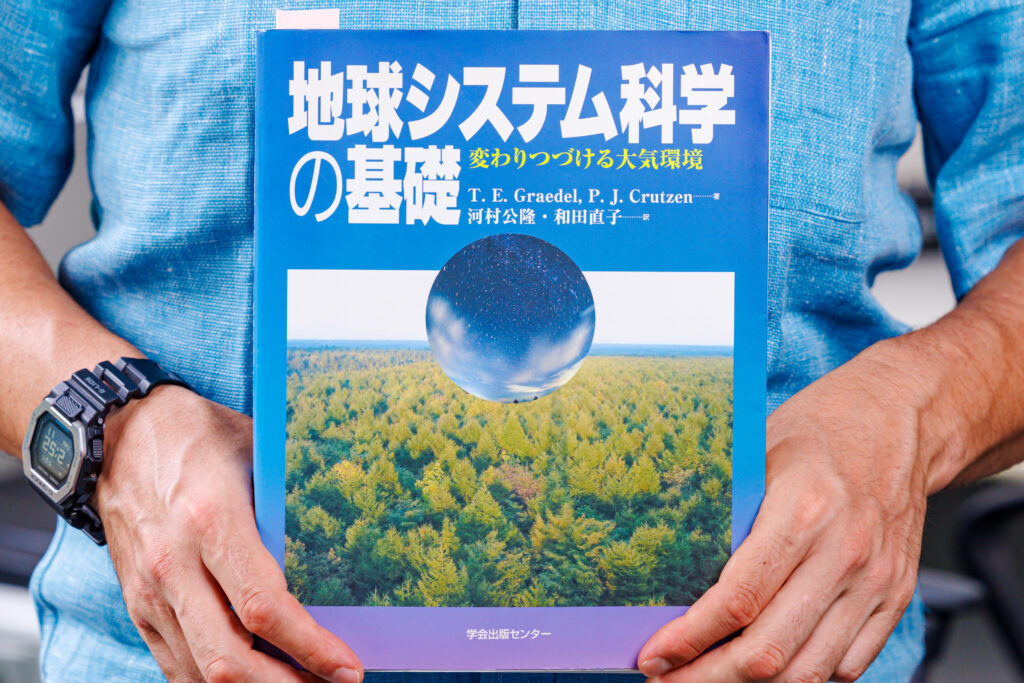
Associate Professor Seba Fuyutsuki of the Faculty of Science and Technology specializes in atmospheric chemistry and researches the chemical reactions of Earth and exoplanets atmospheres through measurements and theoretical calculations. What is the appeal of atmospheric chemistry, and how can it help uncover the mysteries surrounding the Earth’s history and the emergence of life?
Particles suspended in air or other gases are called aerosols. Smoke from a bonfire or mist from a sprayer are examples of one type of aerosol. There are many different types of aerosols, but my research focuses on aerosols of sulfuric acid that drift in the stratosphere, which is 10 to 50 kilometers above the ground.
Sulfuric acid aerosols reflect sunlight, reducing the amount of solar radiation that reaches the surface of the Earth. In contrast to carbon dioxide, which has a warming effect, these particulates have a cooling effect: in the years following the 1991 massive eruption of Mount Pinatubo in the Philippines, the average global temperature dropped about 0.4°C.
One of the main factors for this is thought to be sulfuric acid aerosols. This is because sulfuric acid aerosols are formed by the chemical transformation of sulfur compounds such as sulfur dioxide and hydrogen sulfide contained in the volcanic plume as it reaches the stratosphere.
Understanding the sulfur cycle and investigating the full scope of chemical reactions in the atmosphere

Drawing inspiration from the drop in temperature after the Pinatubo volcano eruption, Paul Crutzen, the 1995 Nobel laureate in chemistry and famous for his work on the hole in the ozone layer, suggested the idea of injecting sulfur compounds into the stratosphere as one way to combat global warming, and scientists have since been exploring the idea.
However, we cannot simply release toxic substances and cause air pollution and health problems. To accurately estimate the effects and side effects, we need to determine the origin of the sulfuric acid aerosol.
Sulfuric acid aerosols are believed to come from sulfur dioxide and carbonyl sulfide, which is the most abundant element in the atmosphere. However, it is not yet understood where carbonyl sulfide is generated on Earth and how it migrates to the stratosphere. One of the main reasons for this is an insufficient understanding of chemical reactions in the stratosphere, which is a different environment from the surface of the Earth.
My laboratory has recently developed a measurement device and quantitative model to measure the concentration of carbonyl sulfide in the atmosphere in collaboration with researchers at the National Institute of Advanced Industrial Science and Technology and the Tokyo Institute of Technology.
We intend to conduct observations in various regions of Japan using these measurement devices and incorporate the results into a quantitative model to determine the chemical reactions that lead to the production of sulfuric acid aerosols in the stratosphere.
Sulfur circulates around the Earth in different forms as part of various compounds such as sulfur dioxide, hydrogen sulfide, carbonyl sulfide, and sulfuric acid aerosols. My goal is to gain thorough insight into the sulfur cycle and the chemical reactions taking place in the atmosphere.
Atmospheric chemistry connected to phenomena on large spatial and temporal scales
The study of the sulfur cycle provides clues not only to current global climate change, but also to the actual atmosphere of primordial Earth and exoplanets. In the research project Geochemistry of CO Worlds selected by the Ministry of Education, Culture, Sports, Science and Technology (MEXT) in FY2022, I am working as a member of the theory group to theorize and predict chemical reactions in the atmosphere of the early Earth, where carbon monoxide is believed to have existed in abundance.
Currently, oxygen accounts for about 21% of the Earth’s atmosphere. Oxygen is created by photosynthetic organisms such as the cyanobacteria and plants. We believe that before oxygen began to increase, the atmosphere was rich in carbon monoxide, which favored the creation of complex molecules such as RNA and DNA. The aim of our project is to test this hypothesis.
I consider my day-to-day research activities to be very routine. However, I find this research to be fascinating in that our knowledge of the detailed processes of complex chemical reactions leads to an understanding of phenomena on large spatial and temporal scales, such as climate change, Earth’s history, and the emergence of life.
The book I recommend
“Chikyu Shisutemu Kagaku no Kiso”(Atmospheric Change: An Earth System Perspective)
by T.E. Graedel and P.J. Crutzen, Japanese Translation by Kimitaka Kawamura and Naoko Wada, Gakkai Publishing Center

In the 1950s, the United States, the Soviet Union, France, the United Kingdom, and other countries conducted nuclear tests, and out of concern for the effects on the atmosphere, scientists created the field of atmospheric chemistry. This book was written by pioneers in the field. Well illustrated, this book is an excellent introduction to atmospheric chemistry.
-
Seba Fuyutsuki
- Associate Professor
Department of Materials & Life Sciences
Faculty of Science and Technology
- Associate Professor
-
Graduated from the Department of Chemistry, Faculty of Science, Kanazawa University. Completed doctoral course at Interdisciplinary Graduate School of Science and Engineering, Tokyo Institute of Technology, and worked as a researcher at Department of Earth and Planetary Sciences, Tokyo Institute of Technology, and as an assistant professor at Department of Materials & Life Sciences, Faculty of Science and Technology, Sophia University before assuming his current position.
- Department of Materials and Life Sciences
Interviewed: July 2022